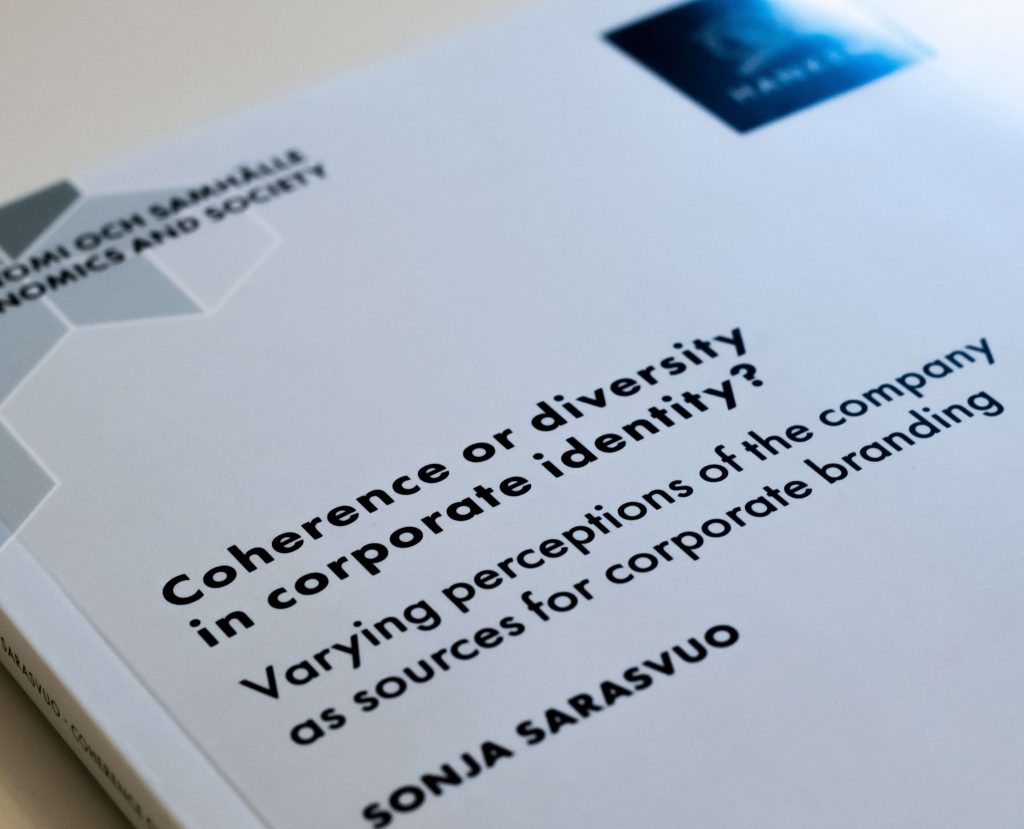Last week, I defended my doctoral dissertation at Hanken. The thesis bears the title” Coherence or diversity in corporate branding – Varying perceptions of the company as sources for corporate branding”. It’s about identity (basically, ’who am I?’), but specifically in the context of companies, discussing the concept of corporate identity.
At a general level, my thesis has one main message
Corporate brands do not always need to be coherent and consistent.
This means that companies do not necessarily need to strive to align their stakeholders’ perceptions of them. In my thesis I have focused on exploring the diverse perceptions of employees and customers. In addition, companies may also consider a multitude of stakeholders such as shareholders, suppliers, and partner organizations.
My thesis shows that stakeholders have diverse perceptions of companies for many reasons. Employees’ perceptions of a company’s identity may vary depending on their professional background or culture. It further depends on the clients they interact with on a daily basis. Likewise, customers’ perceptions of companies vary depending on their experiences with companies; for instance, the length of the relationship with the company and what services they have bought specifically. While these insights may apply in many different companies, the findings are specifically drawn from a business-to-business context, where companies market their services towards other companies.
Importantly, the thesis shows that it can be hard for stakeholders to identify with corporate brand that is too uniform. A brand that is too uniform may even be considered irrelevant, as stakeholders may ask: ”how does my identity, and how do my perceptions fit together with this brand?”
Then what should companies do about this?
Listening to and learning from multiple stakeholders
A first step could be to listen and learn about this perceptual diversity among stakeholders. This could be done, for example, by adopting a mentality of co-creation, meaning that the brand is developed together with stakeholders. For example, companies could invite their employees or customers into different branding processes to voice their opinions on topical matters. As another example, companies could facilitate brand communities where stakeholders can interact – internally or externally. New ideas for the brand may emerge from these communities that companies can learn from.
Evaluating diversity and stakeholder representation in the corporate identity
Another step could be to consider how the company presents itself, and its corporate identity. Is there something in the current branding processes, such as brand communications, that could be changed? For instance, a company can consider how their strategies and values are communicated, and whether they adequately represent a multitude of stakeholders. Does the company present itself as a uniform entity that provides uniform services, or as a network of people with varying skills, together providing a variety of services that can be tailored as unique solutions to customers?
Evaluating the diversification of the product or service portfolio
The company could also have a look at their product or service portfolio, which can be seen as part of their corporate identity. Does the company choose to be a generalist or a specialist? Do all offerings complement each other, or does the company diversify its portfolio by offering multiple independent products or services (i.e., service diversification)? My thesis suggests that all services do not necessarily have to complement each other or interest all customers, but service diversification typically requires maintaining sufficient service quality for each individual service.
Regardless of the specific path that a company chooses to take with their brand, identity-related questions remain important for all companies, including ”who do we want to be as a company?”, and what do we promise towards or stakeholders?”. These questions are not answered in a day, nor are they meant to be. When branding occurs as a continuous process of company-stakeholder interaction, there is room for minds and directions to change along the way.
Sonja Sarasvuo
Sonja Sarasvuo defended her thesis titled ”Coherence or diversity in corporate branding – Varying perceptions of the company as sources for corporate branding” at Hanken on March 18th 2022.

